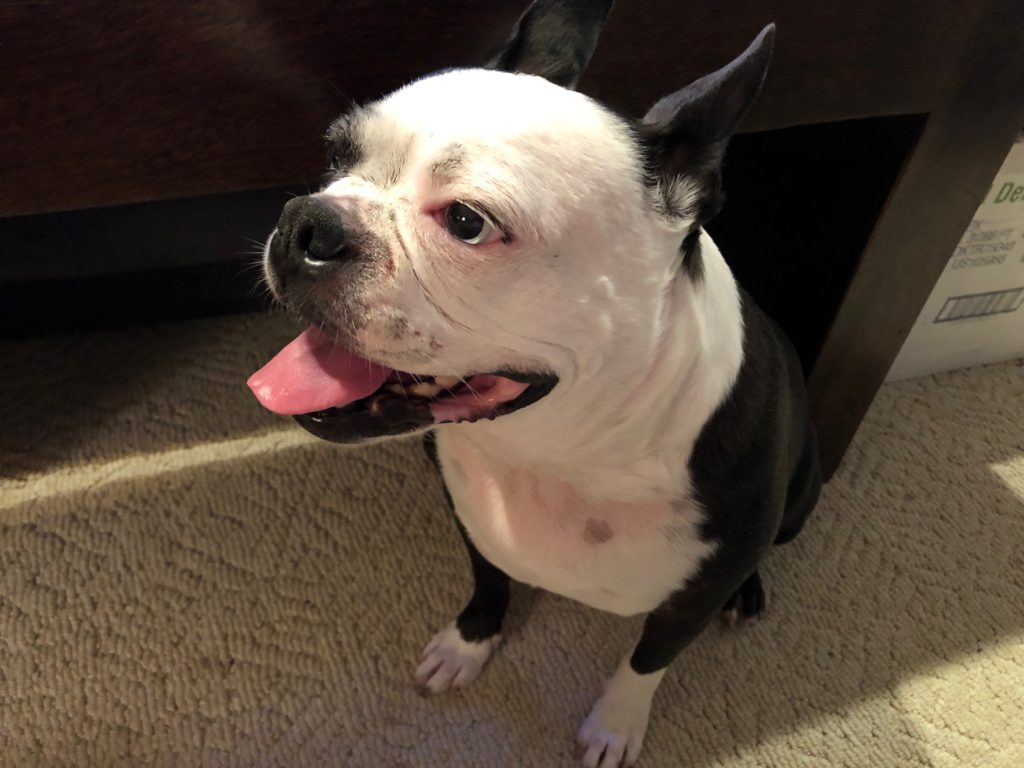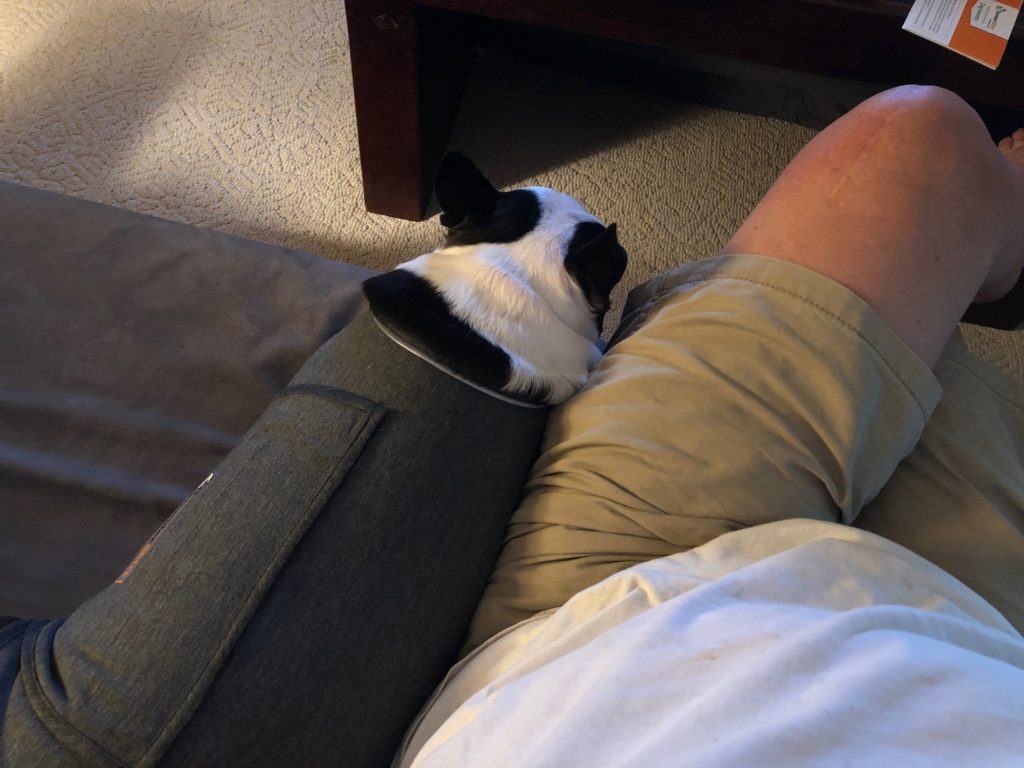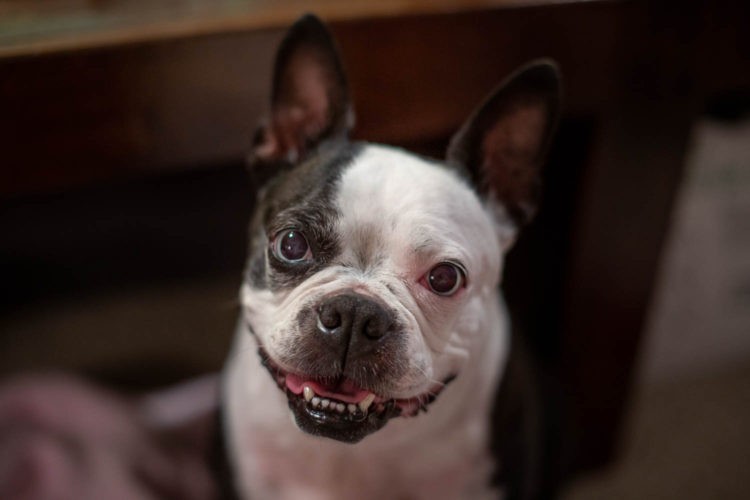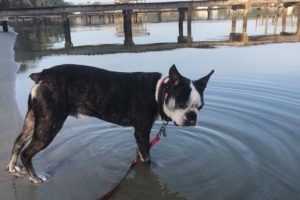Storm season is here! Although, where I live, its storm season all year long! To those of you who regularly foster rescue dogs, if you’ve never witnessed a dog’s storm phobia, eventually you will. In fact, in 2001, the Journal of the American Animal Hospital Association published a survey of owners of dogs afraid of storms and found that rescue dogs had significantly higher incidences of thunder phobia. Interestingly, some breeds such as herding dogs and hounds had a higher prevalence of thunder phobia as opposed to other breeds.
I am not a veterinarian nor an animal behaviorist. I present my understanding of health or behavior issues based on personal experience and research I’ve done. If you have a dog with a health or behavioral issue, seek professional guidance. I hope you find my post useful.
This post contains affiliate links. As an affiliate, I may earn a small commission on qualifying purchases, at no additional cost to you.
Helping Dogs with Storm Phobia
Why should we understand and learn how to help dogs afraid of storms?
- storm phobia may become severe and become life-threatening.
- some dogs with storm phobia also suffer from other phobias such as fireworks or separation anxiety.
- storm phobia can be expensive to manage and it may impact your lifestyle.
- rescue dogs with storm phobia may be difficult to adopt out.
“I make sure someone is home when it is supposed to be storming. My dog jumped through a closed window once, breaking the glass and cutting herself pretty bad. I can’t let that happen again. She doesn’t tolerate being in a crate.”
a friend who rescues
Why Is My Dog Scared Of Storms?
It’s unclear why dogs develop storm phobia. Possible causes of storm anxiety and phobia include:
- genetics
- a traumatic or aversive event
- intentional or unintentional reinforcement
- poor socialization/restrictive learning experiences when a puppy
49% of dogs show a significant fear response to fireworks. While young puppies demonstrate fear and phobia behavior at a young age, most true noise phobias develop over time. The earlier you implement a management and treatment plan, the better. [1]
Learning The Difference Between Fear, Phobia, and Anxiety
The fear response to certain stimuli is normal and natural. Fear or apprehension helps a creature seek safety, protection, and avoid danger. A napping dog that wakes up and seeks shelter or comfort when hearing thunder may be exhibiting a normal response to storms. Think about what outdoor animals do! They seek protection when it storms.
It’s also normal for a pet to act afraid as storm intensity increases. For example, a dog may lay near their human when scared during a storm. Normal, adaptive behavior, if you ask me. My dog, Otis usually wants to be in the same room with me during severe storms. He is “on alert” but not anxious or panicky. I believe, depending upon the dog’s overall presentation, “seeking cover” or comfort can be an adaptive behavior. To expect our pets to be unflappable during storms is unrealistic and honestly, not fair.
The problem occurs when fear responses escalate and worsen after each exposure.
Phobia
Phobia, on the other hand, is a disproportionate fear of an actual or perceived threat. Noise phobias can be caused by gunshots, fireworks, thunder, and other sources, such as vacuum cleaners or even the sound of birds! As dogs continually experience fear in the presence of these sounds, they begin to include other associations as well. A dog with gunshot phobia may become anxious or panicky at the sight of a rifle.
For example, my father was out tending his dogs when the next-door neighbor began target shooting on the property next door. The dog immediately associated my father as the source of the gunfire noise. It took a while for the dog to resolve that fear.
The dog with storm phobia demonstrates fears and anxiety in anticipation of the noise (thunder) because of these new associations. Dogs with storm phobia will often respond to the presence of these associations before hearing the original, fear-producing noise. Associations might include:
- changes in the barometric pressure
- an increased electrical charge in the air
- darkening of the sky that’s not associated with night
- wind
- rain
- thunder – distant or close
- flashes of lightning
or any of the above combinations. For example, a rain shower may not bother a dog at all, and a dark sky may not bother a dog at all. However, rain showers together with a dark sky might trigger a phobic reaction. It’s all about the individual dog’s associations with said triggers.
Indeed, dogs can be afraid of storms and not afraid of fireworks, or vice-versa. Your observations will tell you. Until you know what your foster dog is afraid of or not afraid of, be home with your new foster dog for that first storm. Be home for fireworks.
Anxiety
Whereas fear is a distressing emotion in response to a real or perceived threat, anxiety is defined as the state of apprehension or anticipation of a future threat, that often impairs physical and psychological functioning. [1] Fear is temporary. Anxiety and phobias persist beyond the appropriate period.
Storm Anxiety Symptoms In Dogs
I love stormy weather. The wind, the tension in the air, the rain, and distant rumbling of thunder are exciting to me. But the truth? I feel tense during severe thunderstorms. Do you? There is a slight risk of danger during a severe thunderstorm. I move indoors, stay away from the windows, turn off/unplug my electronics, stuff like that. Dogs who don’t suffer from storm phobia are also feeling a little tense, I’m sure of it.
Dogs with storm phobia will demonstrate an exaggerated anxiety response to storm triggers.
You may see these signs or symptoms of storm anxiety:
- pant
- drool
- tremble/shake
- pace
- get sweaty paws
- whine, cry, bark, howl
- destroy property by chewing or digging
- attempt to escape, like through a window
- harm themselves
- loose bladder/bowel control
- refuse to eat
- do not tolerate being alone
- display aggression
These behaviors can intensify if you leave a dog home alone, without a human. Do not expect a companion dog to help your storm phobic dog. They normally cannot.
How Can I Help My Dog Cope With Storm Phobia?
If your dog is scared of thunder and storms, talk with your veterinarian about the current, science-based, best practices for helping dogs with storm phobias. When caring for a dog with severe storm phobias, it’s a good idea to seek the help of a veterinary animal behaviorist. (not the same thing as a dog trainer!)
Veterinary animal behaviorists are knowledgeable and skilled in the application of behavior management and modification techniques. In addition, an animal behaviorist will provide recommendations to your veterinarian for medications based on their assessment. I’ll talk about medication a bit later.
Managing Your Rescue Dog’s Storm Phobia
MOST IMPORTANT: It’s easier to manage your dog’s storm phobia BEFORE the dog exhibits behaviors, not after the dog is in distress. Know your weather forecast! Prepare your home before the storm hits. Apply your supportive tools or interventions on or in your dog a minimum of 45 minutes to an hour before the first storm triggers arrive.
I’ll admit, sometimes that’s hard to do! The weather where I live is constantly changing and quite unpredictable. I can go to bed believing that there are clear skies and awaken to Sassy panting because there’s a pop-up thunderstorm. Nevertheless, I persist in being as proactive as I can be.
Certainly, the first step in helping your rescue dog with storm phobias is to understand this is not going to resolve quickly. You have to learn your individual dog’s triggers, which methods help best, most importantly, be persistent and patient with your plan.
Design your plan
- Buy a journal. Record your observations and report your dog’s progress.
- Watch the weather forecast and BE PREPARED! When the weather forecast is wrong, stay the course. Weather happens!
- Identify the early triggers – Is it wind? Barometric pressure? Rain? Flashes of light? Pay attention to your dog’s behavior and appearance and record your observations. Your dog may show early behaviors before the storm arrives. Use your toolbox before the dog becomes anxious.
- Identify tools and techniques that help your dog. (and hopefully prevent an escalation of symptoms) It is trial and error, so be patient and persistent. I’ll cover tools and techniques in another section.
- Use prescription medication when warranted. Please use medication if your dog needs it. Even if your dog has mild to moderate storm anxiety, medication can make a difference. Anxiety and panic are uncomfortable to your dog. Provide them with relief.
If at all possible, do not let your storm phobic dog experience storms alone. Often they will exhibit elevated anxiety behaviors when alone.
Helping Sassy Cope With Storm Phobia
Sassy’s owners sent a note along with the biggest bottle of (generic) Benadryl I’d ever seen: “Sassy doesn’t like storms. Give her 50 mg (two tablets) and pray it works.”
We are going to design a different plan for Sassy. Benadryl is sedating and may have mild anxiolytic benefit, but for dogs with storm phobia, it isn’t the first-choice medication. Plus, Sassy already takes an antihistamine for her allergies, so double-dosing her with this class of medication makes me uneasy.
I’m early in the understanding of Sassy’s storm phobia. In other words, with only a few mild to moderate thunderstorms having blown through, I have a limited understanding of how bad her anxiety can become during a more severe storm.
Here’s what I know: She doesn’t like thunder and she doesn’t like rain.
How do I know this: at the first rumble of thunder or sound of rain, she seeks out her human, her pupils having already dilated, and she begins to breathe faster and soon thereafter, pant. She refuses food of any type.
What helps her: I’m not sure, yet. We are using a thundershirt, homeopathic drops, and trying to manage what she can see and hear. Most of all, the humans remain calm, go about their normal behavior and routine, and be present and available when the dog needs to be close and in contact with you.

What Can I Give My Dog For Anxiety During Storms?
When it is storming outside, It’s hard to watch our dogs pant and shake and pace and hide. We want them to feel better. We want to help them. Many of us try to avoid using prescription medications.
We hate giving our dogs prescription medication, don’t we? There is social pressure to provide our pets an all-natural, no-processed, “species appropriate” holistic lifestyle. I get it.
However, if our dogs suffer from specific anxieties such as storm phobia, separation anxiety, or noise phobias, giving medication may be the kindest thing you can do to ease your dog’s storm phobia.
I remember back in the day when I needed to give my dog an oral sedative medication. She became woozy, wobbly, peed on herself, and sometimes could not stand. It was horrible. I knew she needed it but it didn’t make it any easier.
These days, veterinarians have many more choices when your dog needs anti-anxiety medication. Some medications are given every day and some medications are given as needed. Many dogs with storm phobias need both daily and PRN medications. Your veterinarian or animal behaviorist can choose the best medication or combination of medications that will offer your dog relief.
Your dog doesn’t necessarily need to take this medication for life. Some dogs take these medications only during storm season. I understand the desire to keep our dogs as “chemical-free” as possible, however, denying your dog access to a medication that can relieve them of severe anxiety and panic isn’t kind. If your dog has storm phobia, they are MISERABLE during storms.
Management Tools and Techniques for your Storm Phobic Rescue Dog
Here’s a list of tools and techniques you can try to manage your dog’s storm phobia. These are not in any particular order, but please let your veterinarian or animal behaviorist know ALL products you are using.
- Maintain your dog’s good health and nutrition. A dog that doesn’t feel well physically will have a harder time.
- Purchase a Thundershirt, Anxiety Wrap, Storm Defender Cape I’ve used the Thundershirt on several dogs and it’s my product of choice.
- Use Pheromones such as Adaptil Products. I’ve used all three: Diffuser, collar, spray.
- Homeopathic calming products like HomeoPet’s Storm Stress or Rescue Remedy
- Melatonin
- Blankets -for covering windows and for burrowing
- If your budget allows – purchase black-out shades for windows.
- Create a “safe room” in a closet or windowless bathroom.
- Medications as prescribed by your veterinarian
- Calming Chews as recommended by your veterinarian.
- Massage, such as T-Touch
- Provide background noise: Music/white noise/TV/Box fan
- Dog-specific classical music such as Through A Dog’s Ear
- Go for a car ride (Sassy’s favorite)
- Exercise your dog well every day, but especially days it is expected to storm.
- Always project a calm attitude.
Prior to a storm’s arrival
Once your dog demonstrates anxious behavior, you are behind. You want to stay ahead of the game to manage your dog’s storm phobia before the first sign of the storm.
- Prepare your house well in advance of the storm’s approach and arrival. Draw the curtains, close blinds, cover windows, turn on background noise
- Prepare your dog well in advance. Put the wrap/shirt/cape on your dog. Dose them with PRN prescription medication or one of the OTC products you’ve found to work well for your dog.
- Prepare yourself well in advance. You will plan to be calm, steady, maintain your routine, and be available to your dog. Let them snuggle with you.

During a Storm
- If you must leave your storm phobic dog home alone during storms, make sure they tolerate crating before your crate them. While crates may be a normal “safe space” during fair weather, they may not be a place your fearful dog feels safe during a thunderstorm.
I’ve heard heartbreaking stories of dogs breaking out of their crates during storms, some sustaining serious injury. Along those lines, NEVER double up dogs in a single crate. Stressed out and fearful dogs may become aggressive with each other in moments of panic. - If your dog is destructive to property or eliminates bowel/bladder inside your home, DO NOT SCOLD. DO NOT PUNISH. The dog is panicking during this storm. They are terrified! They are not being disobedient.
- What if my dog climbs into the bathtub?
Dodman reports, “I’ve noted time and time again that storm phobic dogs – about 50% of them – climb into the sink, bath, jacuzzi, shower pedestal or squeeze themselves behind toilet tanks or up against metal radiators or pipes during storms. Presumably, they have found by trial and error that there is some degree of protection in these locations. All of these locations represent electrical grounds that would dissipate a built-up static charge.” [3]
In other words, let them! Build a safe space around it. Get in there with them! - My dog shocked me when I touched them! Further support that static electricity builds during storms and our dogs may feel this. Some people use a dryer sheet to wipe their dog in an attempt to reduce static electricity.
“If your dog is afraid, get them out of the situation or comfort them. To do anything less is inhumane.”
Suzanne Clothier
To Comfort or Not To Comfort.
While conducting research for this blog post, I read several articles that included recommendations to NOT comfort your anxious dog! What? This cannot be correct! I dug further into my collection of articles.
To comfort or not to comfort a dog during a fear response is a hotly debated topic. Some professionals believe you can make a dog’s fear worse by providing reassurance, comfort, or touch during times when a dog is anxious and fearful.
However, the more current writings from certified animal behaviorists support the belief that comforting your anxious dog during a storm is calming and therapeutic. In fact, comforting your dog provides your fearful dog with positive associations during storms.
Without a doubt, the most important factor in helping your storm phobic dog is YOU and the healthy relationship you already have with your dog. If YOU are anxious, your dog will likely be anxious. When you are calm, your interactions are calm. Your calmness will provide security and comfort to your pet. Speak to them in a reassuring voice, check your tone, your body language, your confidence. It should be noted, there is a difference in coddling and comforting.
What about those CDs That Desensitize Dogs to Thunder?
What is Desensitization, anyway? It is a process where a human or animal is presented with a noise or object or experience at a low level of intensity and then the intensity is slowly increased over time until the noise or object or experience is no longer bothersome. There are several “desensitization program” CDs on the market.
Interestingly, desensitization programs don’t seem to work as well for storm phobia as they might work for other noises such as gunshots or fireworks. The reason isn’t clear, but perhaps the CD program is only desensitizing sounds, and can’t desensitize other weather associations like the changes in the barometric pressure, a different smell in the air, or the static electricity that builds as a storm approaches. [3]
If you have a young dog with very mild fears and anxieties during storms, a CD program may be of benefit. On the other hand, if a rescue dog’s storm phobia is advanced, these programs may not be as effective.Your animal behaviorist will be your best guide. Animal behaviorists are knowledgable and skilled in helping you develop specific training techniques that can help influence how your storm-phobic dog responds to approaching storms. I know my goal is for Sassy’s tail to wag at the first sound of thunder instead of her beginning to pace and pant. It is a long-term goal!
Is your rescue dog storm phobic? Share your stories with us. What’s working? What’s frustrating? Where are you struggling? Where is your dog struggling?
Article Citations
- Curtis, T. (2013 September/October). Noise and Storm Phobias in Dogs. retrieved from https://todaysveterinarypractice.com/on-your-best-behavior-noise-storm-phobias-in-dogs/
- Radosta, L. (2016 July). Storm Phobia In Dogs. retrieved from https://files.brief.vet/migration/sectioned_content/29641/storm-phobia-in-dogs-29641-sectioned_content.pdf
- Dodman, N. (2011 August 18). Thunderstorm Phobia In Dogs – An Update. retrieved from https://www.veterinarypracticenews.com/thunderstorm-phobia-in-dogs-an-update
Further Reading on Storm Phobia…
Thunderstorm Phobia In Dogs – Safety Tips
Boom! Boom! Helping Your Dog With Thunderstorm Phobias
Fears and Phobias
Can You Reinforce Your Dog’s Fear




